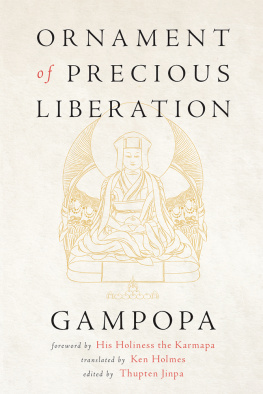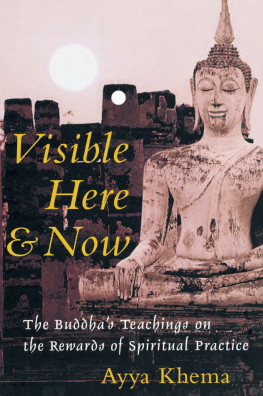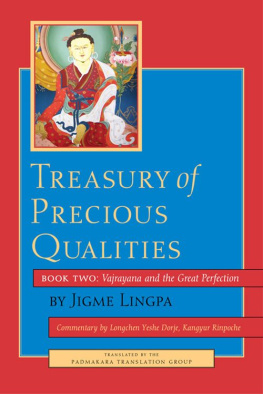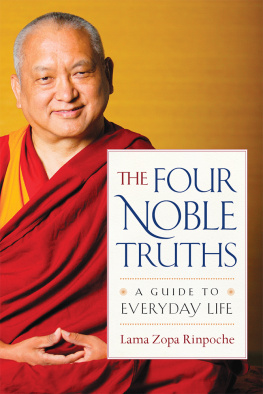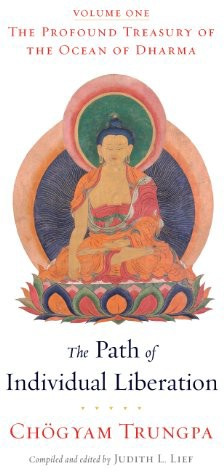
Just as it is possible to obtain the silver that is in ore, the oil that is in sesame seeds, and the butter that is in milk, so is it possible to attain the buddhahood that is in all sentient beings.
GAMPOPA
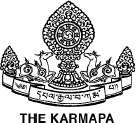
Foreword

When we consider the life and achievements of Lord Gampopa, it is self-evident that he was extraordinary and highly talented. Nine hundred years ago in the snow land of Tibet, few people had such great capacity. Tibetan Buddhism in general and the Dakpo Kagy in particular owe him a profound debt of gratitude.
Before he renounced the life of a householder to become a monk, he was an accomplished physician, widely respected not just for his knowledge and ability to heal but also for his compassion and his concern for the welfare of others. In addition, he was a devoted husband and a loving father, a good human being. After his ordination at the age of twenty-five, he focused his mind on the Dharma.
There were many different lineages at that time in Tibet. Some only practiced the sutra teachings, others were purely tantric, and there was much mutual suspicion. The genius of Lord Gampopa was to bring together these seemingly conflicting traditions. Having established a strong base in the sutra tradition of the Kadampas, he met the great yogi Milarepa and received the instructions on the six yogas and mahmudr that had been passed down from the great Indian mahsiddhas Nropa and Maitripa. Gampopa was able to unite these two traditions, weaving them into a seamless path to liberation in what is known as the confluence of mahmudr and Kadam.
Milarepa himself acknowledged Gampopas greatness when he predicted that future generations would not call his own lineage the practice lineage of Milarepa but would call it Dakpo Kagy. Of the three Kagy forefathers, Gampopa was the only one to be ordained. Marpa the Translator and Milarepa were lay practitioners. When Gampopa, following the instructions he had received from Milarepa, settled at the remote Daklha Gampo hermitage, a large community of meditators gradually gathered around him, and thus Gampopa established the first monastery of the Dakpo Kagy.
Gampopas own teaching practices became the root from which developed the distinctive system that all the Dakpo Kagy schools follow to this day. Students first studied the lamrim teachings on the stages of the path from the Kadam tradition, and then they were allowed to study mahmudr and other tantric practices. Hence, the extant lineages within the Dakpo Kagy the Drikung, Drukpa, Karma Kamtsang, Taklung, and Barom resemble the branches of a family tree, and Lord Gampopa is our common ancestor. The Ornament of Precious Liberation is our great family treasure and our shared inheritance. lt is my aspiration that through this text the different traditions of the Dakpo Kagyu will rediscover their common ancestry and become a joyous and harmonious family once more.
We should consider reading Gampopas Ornament of Precious Liberation as unlike reading other books. This text has the power of a direct transmission from master to student. Gampopa himself promised that in the future those who were unable to meet him personally should not despair, because reading his two texts Ornament of Precious Liberation and Jewel Garland of the Supreme Path would be identical to receiving the teachings directly from him.
Finally, I would like to commend Ken and Katia Holmes for bringing Gampopas words directly to English speakers. Though there are several earlier translations of Ornament of Precious Liberation, this translation is the most readable and faithful, and the extensive footnotes will be of help to practitioners and scholars alike.

The Seventeenth Karmapa Ogyen Trinley Dorje, Dharamsala
Editors Preface

The text in this volume has a long and rich history in the world of Tibetan Buddhism. Gampopas Ornament of Precious Liberation remains to this day the quintessential understanding of the Buddhist path to enlightenment in the Kagy school of Tibetan Buddhism. Trained in the Kadam teachings stemming from the Bengali master Atia as well in the Mahmudr instructions of Marpa Lotswa and his famed disciple Milarepa, Gampopa presents in his work a unique blending of two important streams of Tibetan spiritual instructions.
The step-by-step instructions developed in this work continue to guide and elevate the attentive reader and practitioner of Tibetan Buddhism today. Imbued by Gampopa with so much insight and helpful instruction, it is not surprising that this manual was considered a classic of Buddhist literature in Tibet. With this new translation, students and teachers of Tibetan Buddhism will have a chance to directly engage with the insights and instructions of a great spiritual master. For the general reader, it offers an opportunity to appreciate the richness of the Tibetan tradition and its creative synthesis of the vast corpus of classical Indian Buddhist teachings.
As the founder and director of the Institute of Tibetan Classics and editor of the present volume, it has been an honor for me to be part of this important translation project, which first appeared as part of an anthology of three path texts in Stages of the Buddhas Teachings, volume 10 of The Library of Tibetan Classics. I thank Ken Holmes for translating Gampopas words into elegant English with such care and diligence. I thank my wife, Sophie Boyer-Langri, for her countless contributions to the work of the Institute. I would like to express my heartfelt thanks to Tsadra Foundation, who generously funded the direct costs of this translation project. The Hershey Family Foundation has supported the Institute of Tibetan Classics during its first decade, for which I am deeply grateful. I would also like to acknowledge the Ing Foundation for its generous patronage of the Institute since 2008. Finally, I thank the Scully Peretsman Foundation for supporting my own work, enabling me to edit this precious volume.
It is my sincere hope that this translation will be of benefit to many people. Through the efforts of all those who have been involved in this noble venture, may all beings enjoy peace and happiness.
Thupten Jinpa
Translators Introduction

The work translated in this volume is the well-known Ornament of Precious Liberation by Gampopa Snam Rinchen (10791153). It has been familiar to Western readers for over fifty years as The Jewel Ornament of Liberation, thanks to the translation by Herbert Guenther, which was so welcome and excellent for its time. The text presents Gampopas explanation of the essential elements involved in a gradual ascent of the bodhisattva path, from the beginner level up to the final awakening of supreme buddhahood. Gampopa was a founding master of the Kagy tradition and is famous within it as the one who integrated the spiritual and literary legacy of the Kadam school.
Ornament of Precious Liberation is the main textbook for the study of Mahayana Buddhism in the Kagy monastic schools and colleges. It is seen as a meditators textbook, inasmuch as it is not an eloquent, scholarly masterpiece or an elaborate discussion but a need-to-know manual of essentials for a meditator. The language is down to earth and direct. The eminent twentieth-century Tibetan scholar Kyapj Kalu Rinpoch, recognized as an authority by lamas of all Tibetan schools, presented this text as an enlightened beings (i.e., Gampopas) overview of the vast scriptures of nontantric Buddhism and commented, Even if you want to spend the rest of your life meditating in a cave, you must know Gampopas
Next page
